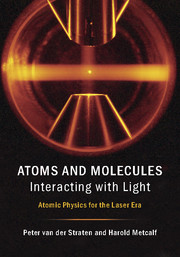Book contents
- Frontmatter
- Contents
- Preface
- Part I Atom–light interaction
- 1 The classical physics pathway
- 2 Interaction of two-level atoms and light
- 3 The atom–light interaction
- 4 “Forbidden” transitions
- 5 Spontaneous emission
- 6 The density matrix
- Part II Internal structure
- Part III Applications
- Part IV Appendix
- References
- Index
5 - Spontaneous emission
from Part I - Atom–light interaction
Published online by Cambridge University Press: 05 February 2016
- Frontmatter
- Contents
- Preface
- Part I Atom–light interaction
- 1 The classical physics pathway
- 2 Interaction of two-level atoms and light
- 3 The atom–light interaction
- 4 “Forbidden” transitions
- 5 Spontaneous emission
- 6 The density matrix
- Part II Internal structure
- Part III Applications
- Part IV Appendix
- References
- Index
Summary
Introduction
The preceding chapters have focused on atomic transitions induced by applied radiation. That is, there is an optical field illuminating the atoms, and their response is calculated. It is implicitly assumed that an excited atom left alone will spontaneously return to the ground state, and conserve energy by emitting light that satisfies E2 − E1 = ħω21 in accordance with the Planck and Bohr pictures. But this spontaneous emission process is not addressed quantitatively in these earlier chapters.
Spontaneous emission is one of the most pervasive phenomena of atomic physics, and yet its origins remain among the least well-understood. The number of misconceptions is enormous, and they are to be found in textbooks, journal articles, and lecture notes. Because the natural decay of an excited atom adds energy to what is usually an empty mode of the electromagnetic field, the process is fundamentally quantum mechanical. Classical or even semi-classical descriptions cannot be assured to give correct answers. This is not to say that such discussion is to be avoided, but only that caution is needed in interpreting the results.
Toward the end of the nineteenth century, many experimental results made it clear that classical mechanics needed to be supplemented by new theories. The first venture into the new physics was Planck's hypothesis that the energy of classical radiating oscillators like those discussed in Chap. 1 would have to be quantized into integer multiples of ħω. This notion led to his famous formula for the spectrum of thermal radiation from a non-reflective object (black body), and this formula describes a radiation field in thermodynamic equilibrium with its environment. The result of Planck's hypothesis in the context of thermal equilibrium plays a vital role in the discussion of spontaneous emission.
Einstein A- and B-coefficients
Soon after Bohr proposed a model of atomic structure consisting of discrete energy levels, connected by radiation whose energy satisfied ΔE = ħω when atoms made transition between them, Einstein published the first serious attempt to connect the absorption and emission processes. Absorption, he reasoned, could occur only in the presence of applied radiation, whereas spontaneous decay occurred without the application of any field.
- Type
- Chapter
- Information
- Atoms and Molecules Interacting with LightAtomic Physics for the Laser Era, pp. 80 - 92Publisher: Cambridge University PressPrint publication year: 2016



